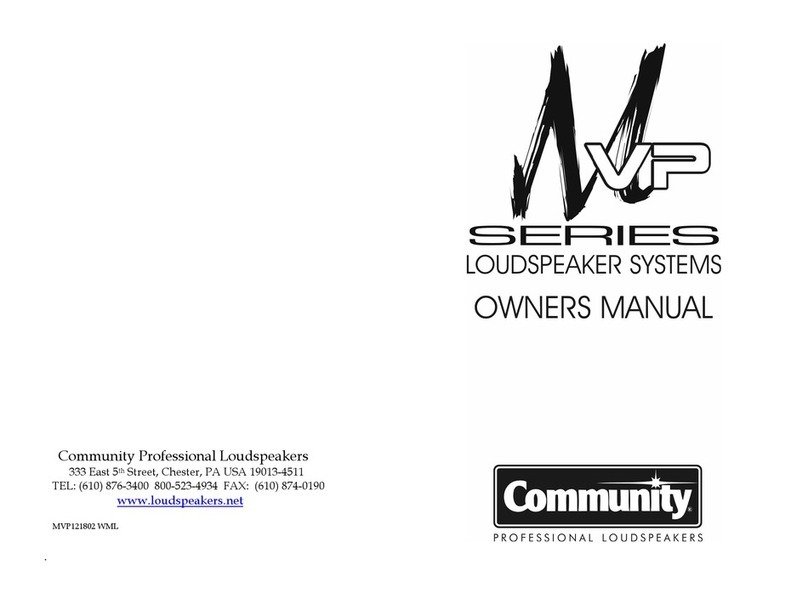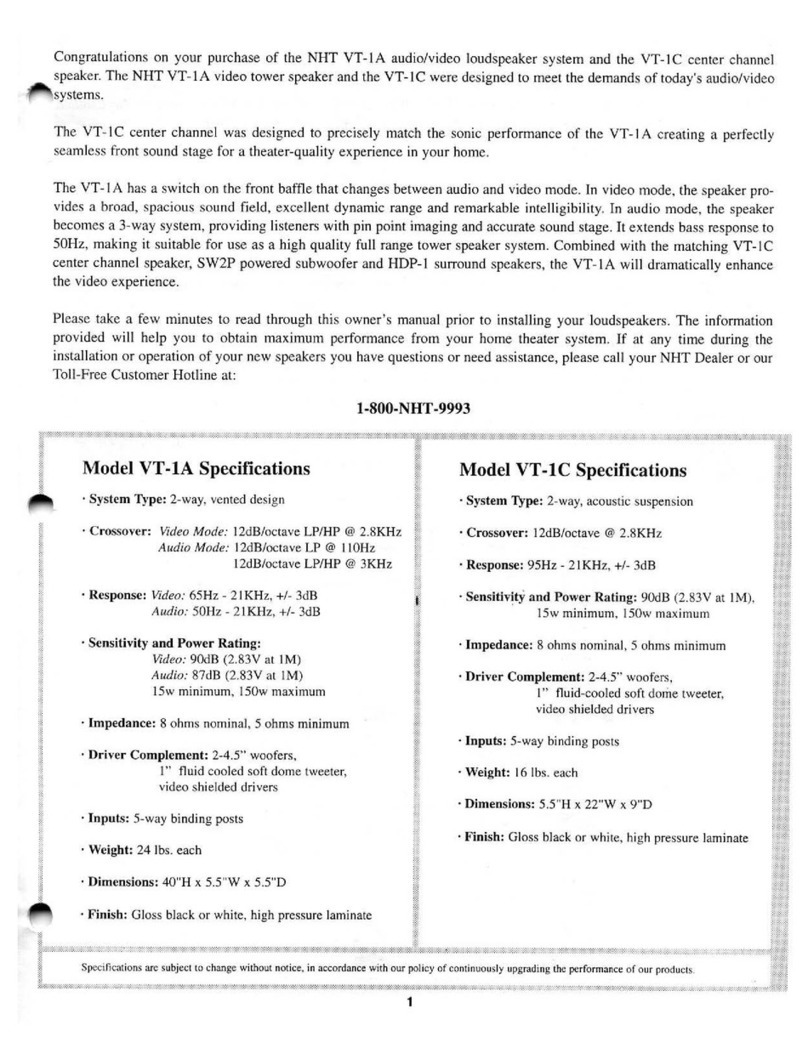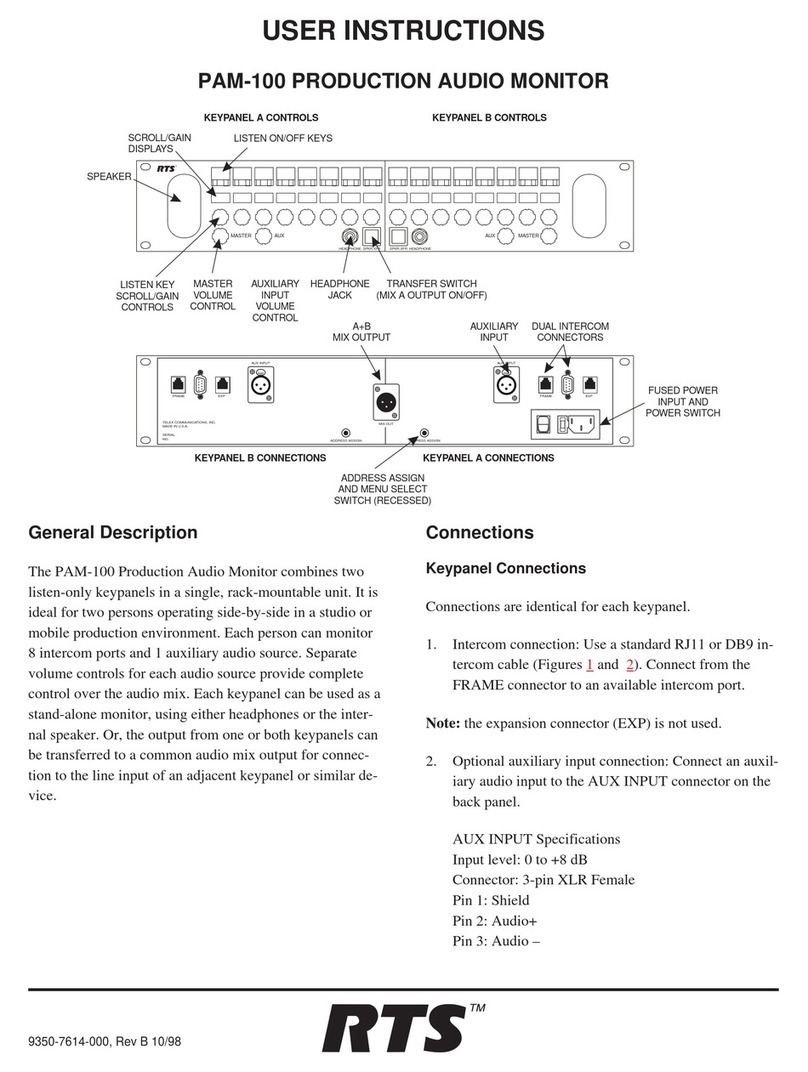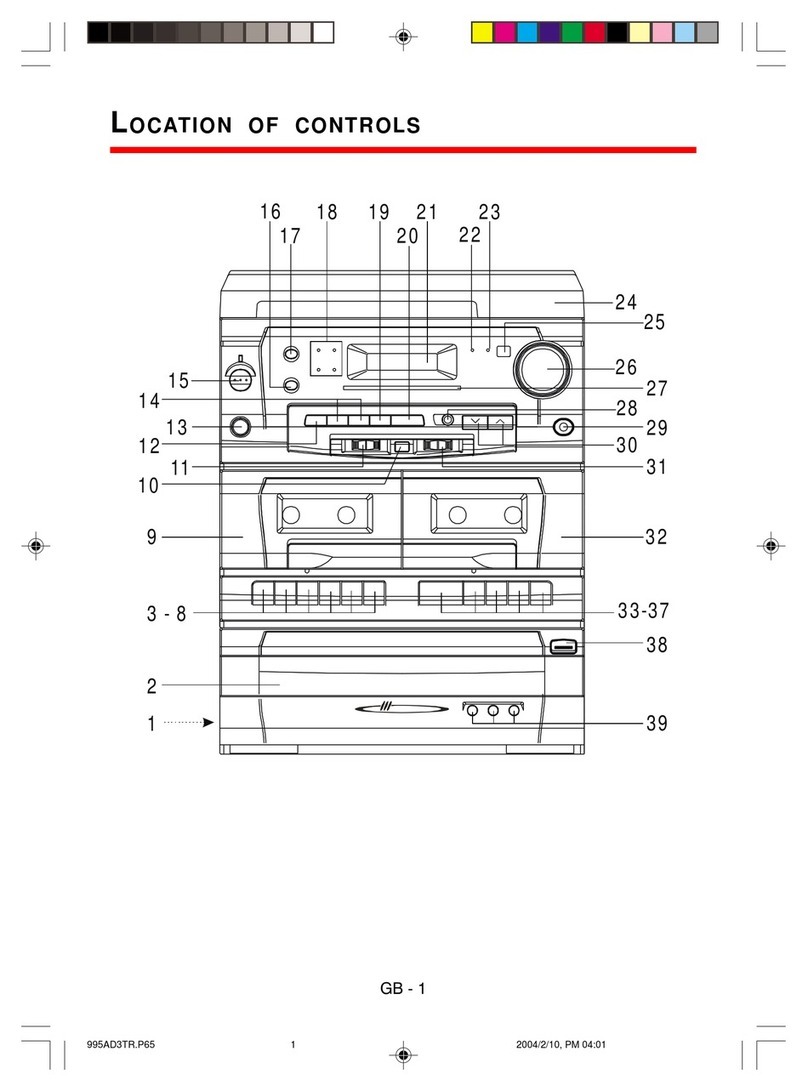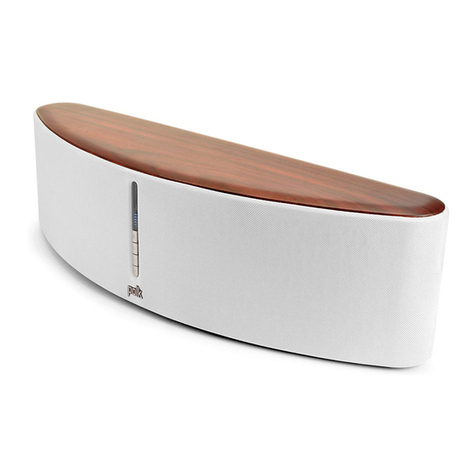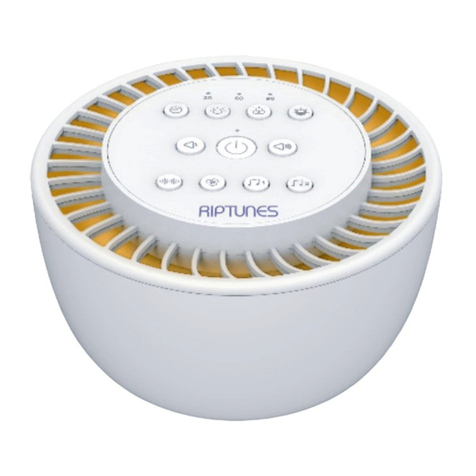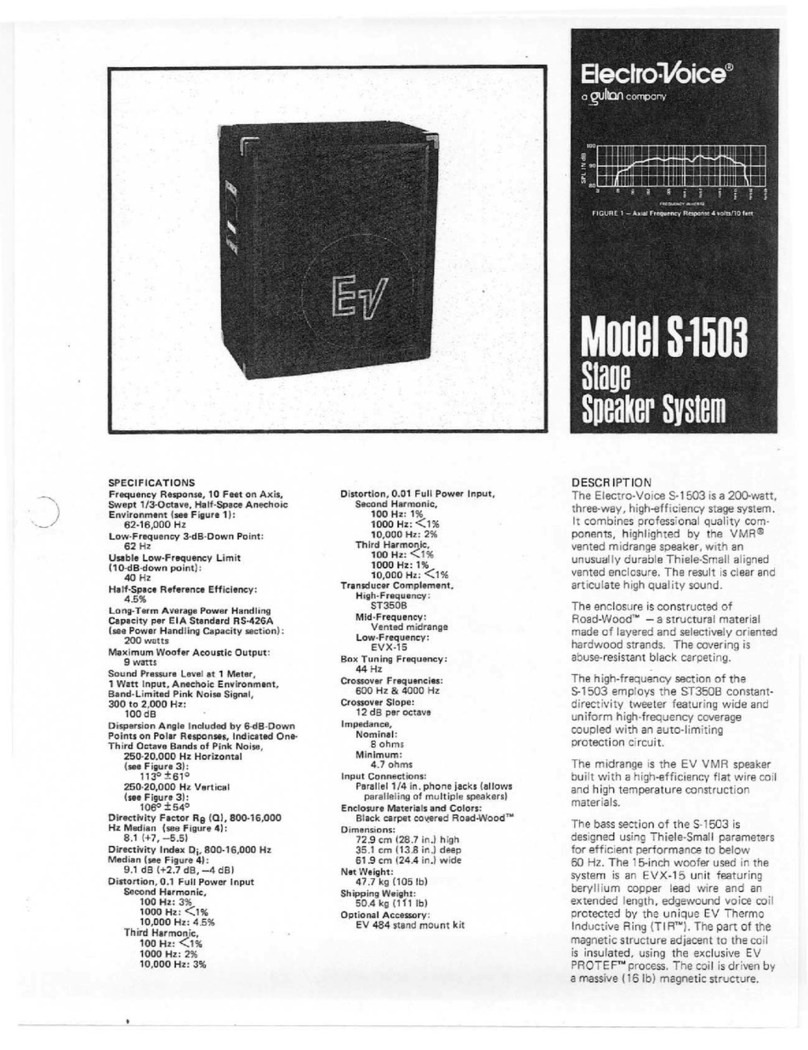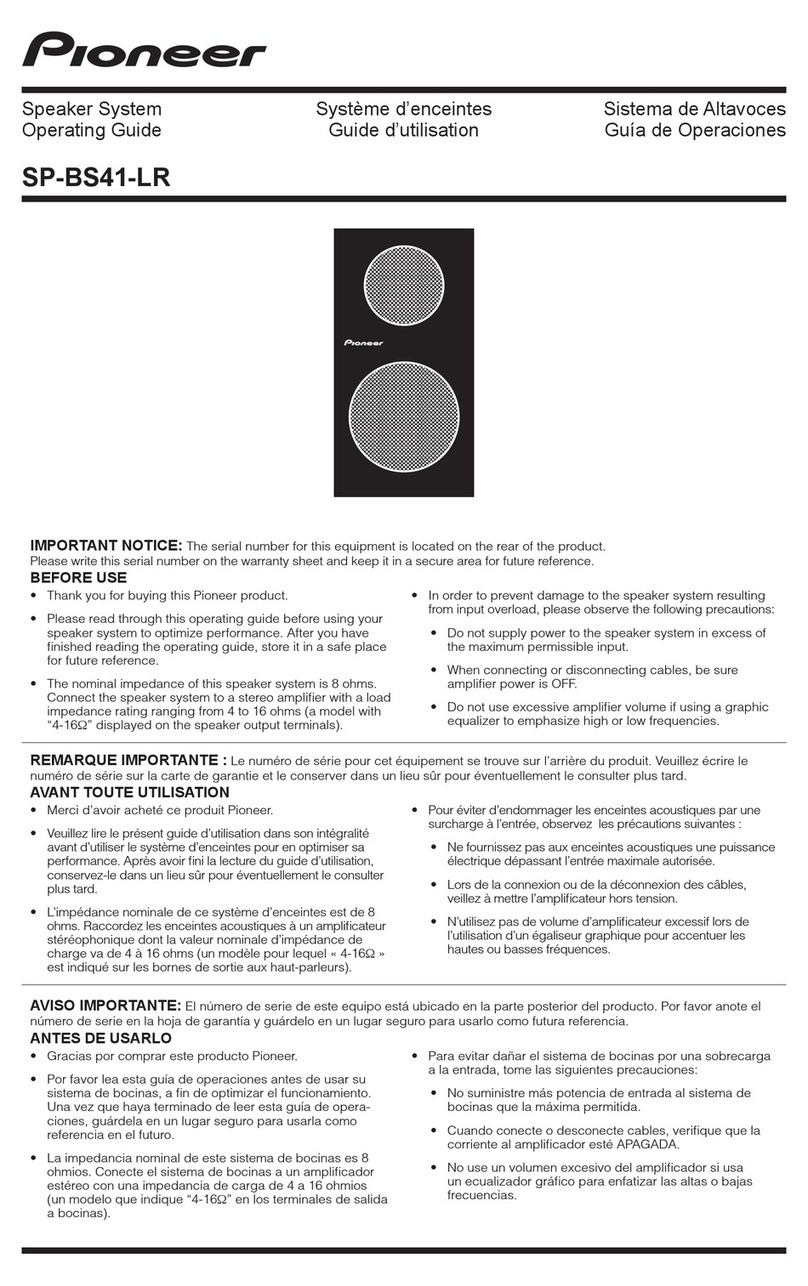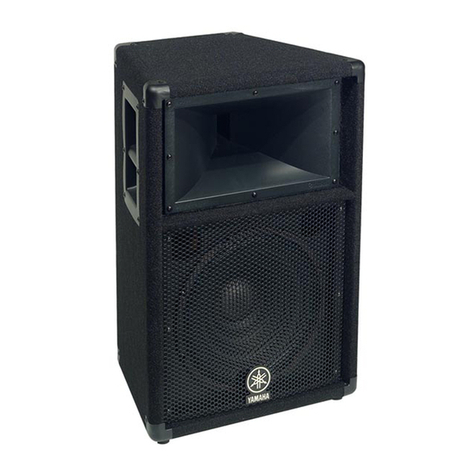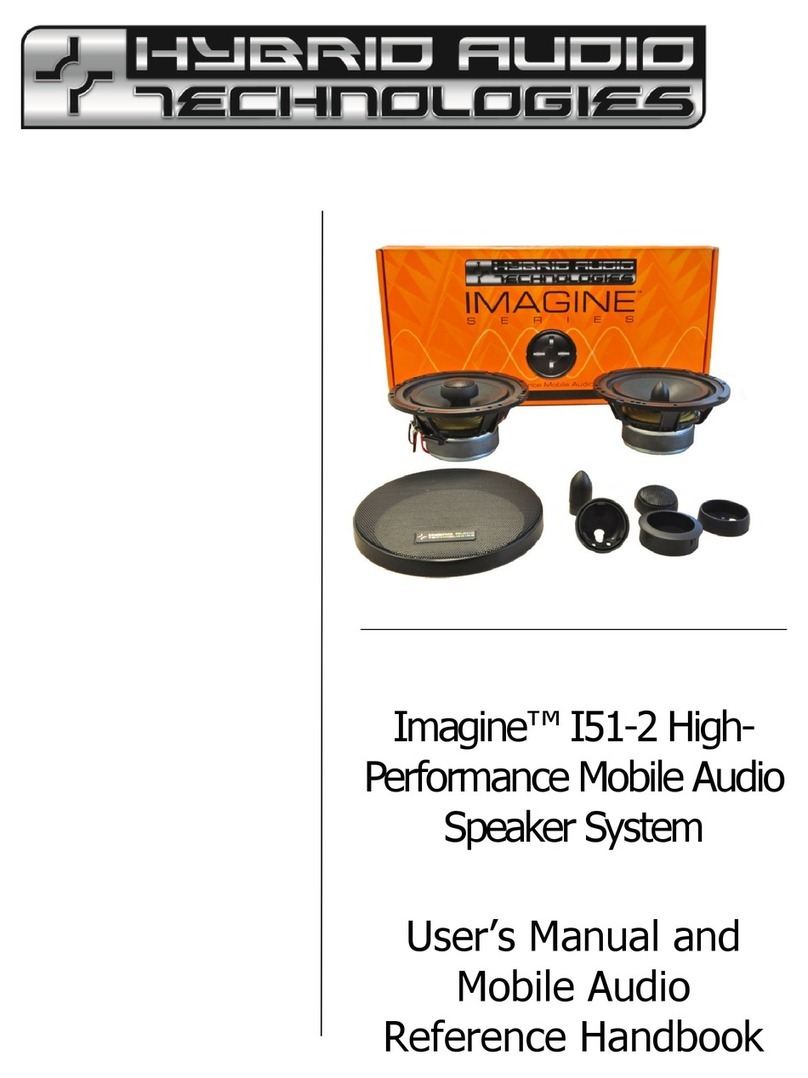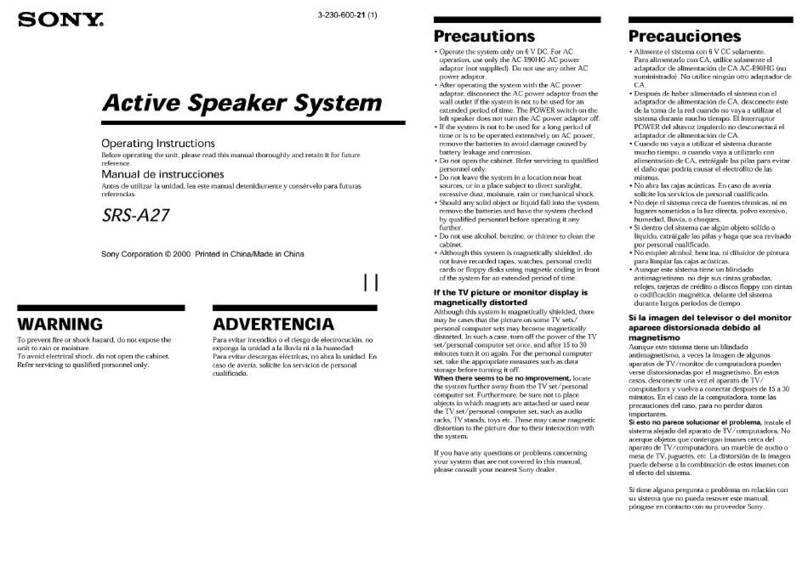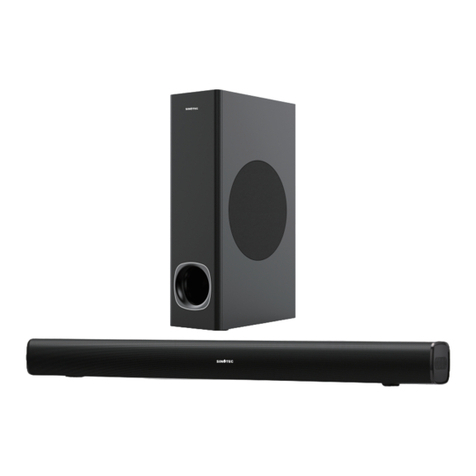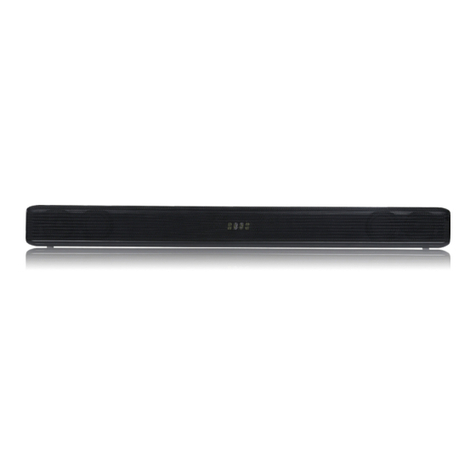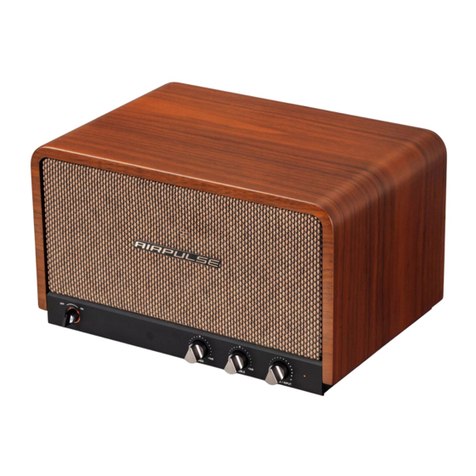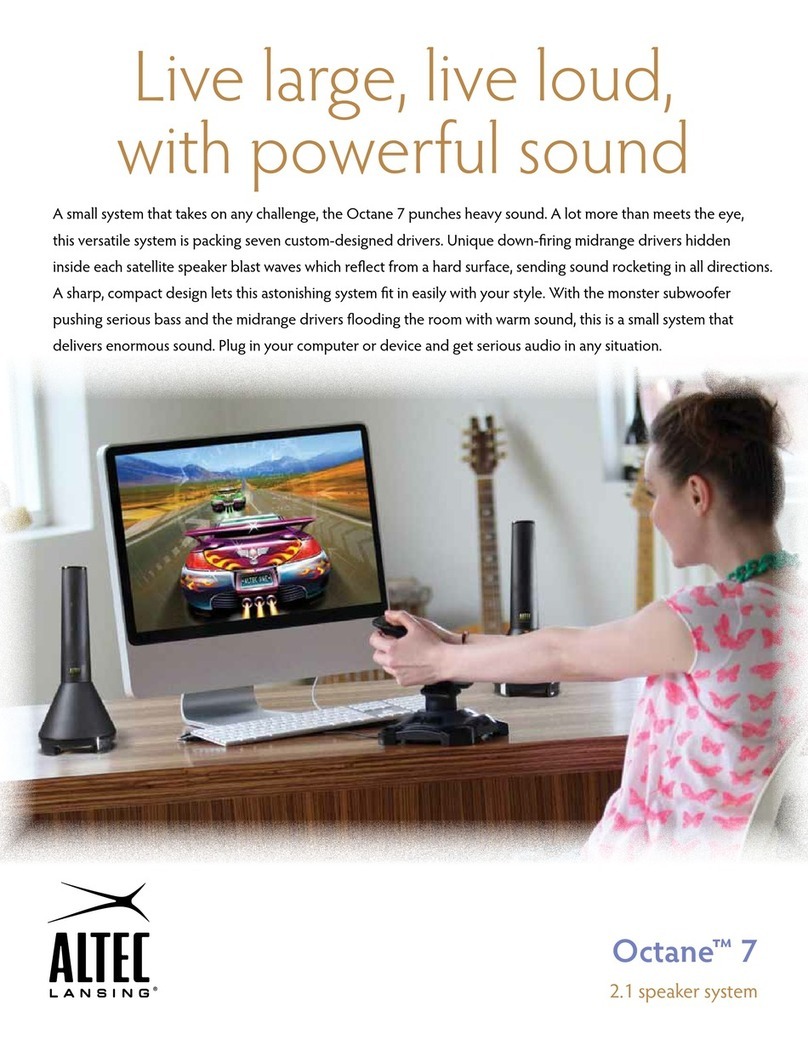KS DIGITAL ADM 10 User manual

Manual
KSdigital
active Reference Monitor
with
FIRTEC(TM) control
ADM 10
KSdigital GmbH | Kossmannstr. 38a | 66571 Eppelborn
fon: +49 6881 9364000 | fax: +49 6881 8808527

1. Important, read all instructions – You should read all information concerning safety and
operation before you use these speakers.
2.Please keep this manual – You may need it in the future.
3. Important, observe the warnings – All warnings on these speakers and in this manual
should be observed by you in the interests of your own safety.
4. Please follow these instructions – All of the tips and instructions in this manual serve to
optimize the operation of these speakers and enhance your listening experience.
5. Water and moisture–These speakers must not be used in wet environments, e.g. in
bathrooms or next to a swimming pool, otherwise the danger of electric shock will exist.
6. Ventilation – This product must be installed in such a way,that the necessary ventilation
is not impeded. For example, the equipment must not be operated on a bed, sofa, carpet
or similar surface where the Black cooling fins can be covered. The equipment must not be
placed in shelving or other locations that prevent acirculation of air at the rear of these
speakers.
7. Heat- Please do not install these speakers near a radiator or other,similar source of heat.
8. These speakers are designed for use with an AC voltage of 115V / 60 Hz or AC230V- /
50 Hz, depending in which country you have purchased these speakers. Never attempt to
operate these speakers with another power supply.
9.Power cable – Please lay your power cable in such a way that it is not a hazardfor tripping
over or can be damaged. In particular, be careful where cable connections and sockets are
located.
10. Ensure that neither foreign objects nor liquids come into contact with or penetrate these
speakers.
11. Properly qualified service personnel may only service these speakers.
12. Repairs – Never attempt to open these speakers or otherwise try and service or repair
this equipment yourself unless this is described in this manual. Please leave this to properly
qualified service personnel.
13. In order to avoid electric shock, never use this equipment with a power extension cable
wherethe electrical contacts arenot completely protected.
14. Ground – Please ensurethat the ground and other connections to the equipment are not
impeded.
15. These speakers are designed to reproduce analog audio
signals. If the equipment is not operated according to these
instructions, the warranty will not be applicable and the user will
be exposed to danger of electric shock.
Warning
Toprevent electric shock, these speakers must not be exposed to rain or moisture.
Seite 2
Safety Instructions
KSdigital Referencemonitor

Thank you for deciding to purchase a KS-digital monitor.
For more than 30 years, KS has been creating top-class sound transmitters with a single target: Natural and
undistorted sound playback. KS products are used by the most famous opera houses, by top producers in
sound studios and in different radio stations and mastering studios. The innovative ADM and C family monitors
have gained a very good reputation with many producers in renowned studios and with popular artists. Designed
according to prerequisites resulting from the idea of sound neutrality, theADM and C series monitors are honest
tools for assessing work.
ATTENTION TO THE FINEST DETAIL
During the development of the ADM family of products, we paid special attention to the
correct timing of the radiated acoustic signals. When an impulse is correctly radiated with
zero latency, this is equivalent to a linear frequency and phase characteristic. The highly
responsive drivers we use, manufactured according to our high specification, combine with the speed
of the utilized MOSFET technology in our amplifiers and the FIRTEC ™ digital equalization in an almost
ideal way to achieve our goal of sound neutrality.
KEY FEATURES OF THE ADM PRODUCT FAMILY
All products of the ADM family are compatible with each other. In this way it is possible to
combine the ADM 20 or ADM 30 with the ADM 10 or operate them together in a 5.1
Surround setup.
ANALOG INPUT:
Symmetrical XLR input (20dBu head room) with a bypass connector to connect the ADM W. A blue LED
indicator on the front warns of possible overloading.
DIGITAL INPUT:
Fullscale results in full volume. Warning, when connected directly to fullscale level such as the output
of a CD-player, use the remote control RC-100 to adjust the volume!
INPUT CONTROL:
If the Fs limit is exceeded (-3dB under the overload limit), the blue LED on the front will blink until the
–3dB limit has been reached again. This ensures that you can listen in safety and that overload distortion
caused by levels above the FullScale limit is eliminated. In case the FullScale level is accidentally
exceeded,a built-inlimiterinterceptsadangerousoverloadandpreventsthe destruction of theloudspeakers
driver.
INPUT SWITCH:
A dial at the rear of the cabinet enables the user to browse through a menu with a number of adjustment
parameters. If a parameter needs to be adjusted, this is possible by pressing the dial and rotating it until
the required value has been set. In this way, under “Digital In Left” or “Digital In Right” the required input
data can be chosen for the signal processor of the DSP. If both inputs are activated, then a mono signal
is generated and reproduced.
REMOTE CONTROL by RC-100 or FIRControl Software (optional):
The RC-100 permits a control of the volume from your work area without a reduction of the word length
of the input signal.
Another choise to make an remote control works per PC with remote control software FIRControl(TM).
Both permit access to all signal processing parameters that can also be adjusted with the dial on the
rear panel of the cabinet.
- per analogue hardware controller
This is connected to the loudspeaker and drives a VCA input signal to
control the amplification of the output stage.
-per digital hardware controller
In the same way as the PC software, this permits access to all signal
processing parameters that can also be adjusted with the dial on the rear
panel of the cabinet.
KSdigital Referencemonitor

KSdigital Referencemonitor
SOUND RADIATION and drivers
Just as important as a correct amplitude and phase in the frequency characteristic is an exact sound
radiation, where the acoustic energy is radiated uniformly across the complete frequency range. The
principle of directing the sound of the tweeter, guarantees a planar wave at the sound opening. The built-
on wave-guide then bundles the radiated sound in exactly the same way as the midrange/bass speaker
does in its transition band to the tweeter, guaranteeing a constant radiation behaviour at the crossover
frequency. The driver of this tweeter, which is capable of high sound pressure, works with a membrane
in ringform. Opposed to normal dome speakers, usually found in hifi and studio systems, this enables
the tweeter a distortion free reproduction of impulse peaks even at very high volumes. The result of the
correct digital equalization is neither corrupted nor nullified by the drivers components. In case of a
complete overload of the input signal, utilization of a limiter in each path protects the components from
destruction.
The carbon fiber membrane of the mid-range chassis also fits into this concept. Carbon fiber is an
extremely stiff but very light material. It ensures a clean bass reproduction with high impulse fidelity
without breaking up in the middle. Together with the neodyn magnet, a remarkably strong impulse and
clear bass tones.
ADM 10 THE REFERENCE CREATED BY DIGITAL PRECISION
The ADM 10 is an active, two-way studio monitor for medium to high volume levels. The signal
processing, including equalization, crossover and correction of the transient behaviour of the
components, is completely done at the digital level. A connection to an existing, digital studio
environment can be made digitally using the AES3 interface. An analogue feed is however, also
possible; a high quality 27 bit gain staging, sigma-delta Converter with 64 x oversampling and a
dynamic of more than 130 dB is responsible for the conversion. The digital signal is further
processed by a fast 60 MHz floating point Sharc DSP in our proprietary designed processor board.
This converts the 24 bit wide input data into a float word with 32 bit mantissa and 8 Bit exponent that
theoretically allows a dynamic of over 1500 dB; noise from overloading, scaling and rounding off
are therefore eliminated. A patented system (Pat. Nr: 198 23 110) raises signals with a word width
of less than 24 bits to an audiophile level. Parameters that can be externally adjusted, such as
volume, filter etc., work directly at the floating point level in the process so that also at this stage,
e.g. when adjusting the volume, no scaling errors occur. On the output side, the DSP works with
two 24 bit D/A converters feeding the high performance MOFSET output stage, that is equipped
with individually selected transistors. With a bandwidth of 100kHz and a rise time of 80 V/us, the
output stage performs to 100W in treble range and 200W at deep mid-range. The resulting sound
pressure is 116dB cont. and 122dB peak.
SPECIFIC FEATURES OF DIGITAL SIGNAL PROCESSING
Digital signal processing must meet the following requirements:
- Separation of the relevant signal parts into treble, bass- and midrange
the analog output socket
- Equalization of the transmission behaviour of each component
-
FIR Equalisation of the complete system
- Overload protection function

KSdigital Referencemonitor
DIGITAL CONNECTIONS
The ADM10 utilizes different left and right loudspeaker cabinets. The differentiation is simple
choice in menu. The different geometry is due to the optimisation of base-length.
For digital connection first you have to choise in speaker menu : "DIGITAL IN R" on "ACTIVE"
for the right speaker and "DIGITAL IN L" on "ACTIVE" for left speaker. Then connect the AES signal
first with the Digital IN socket of the ‘right’ speaker. The left speaker is connected to the active
Digital OUT socket of the right speaker.
! ! The digital source must be connected first to the speaker with the "DIGITAL IN R" put on
"ACTIVE" in paramter menu !
Parameter menu
Power on switch Power socket

KSdigital Referencemonitor
technical details:
analog IN, OUT: XLR-balanced, active DSP-controlled analogue Output +4dbV
digital IN, OUT: AES3 format , 32 –'96 110 KHz,
AD / DA: 27 Bit Gainstaging SigmaDelta, 64fach Oversampling
XLR-balanced, active AES-Out thrupass
DSP: HD-SharcProcessor-32 Bit floating point with 1500 dB dynamic
process: FIRTEC controlled equalization, FIR-crossover, limiter, Preset-EQ, User-
EQ, Room Equalization: Low-, Highshelving, 3 param.EQs, Delay, phaseshifting
drivers: 1" compression driver,
8" carbonbassdriver (2pcs.)
poweramp: 400Watt-RMS, 200 Watt + 100 Watt MOSFET technology
SPL: 118dB cont. / 122dB peak
Remote Control: optional wiht RC-100 or FIRControl Software
Dimensions: 62 X 45 X 38 cm 28 Kg

Function range of values in paramter menu:
Volume:
Total volume 0dB … -31dB
Filter 1:
Frequency X/26 Frequency band of Filter 1 27 frequency bands
Gain Relative level of the correction filter +6dB …'85 -6dB
Q-Factor Frequency bandwidth 0.1,…'85, 5.0
Filter 2:
Frequency X/26 Frequency band of Filter 1 27 frequency bands
Gain Relative level of the correction filter +6dB …'85 -6dB
Q-Factor Frequency bandwidth 0.1,…'85, 5.0
Filter 3:
Frequency X/26 Frequency band of Filter 1 27 frequency bands
Gain Relative level of the correction filter +6dB …'85 -6dB
Q-Factor Frequency bandwidth 0.1,…'85, 5.0
Low shelving:
80Hz EQ +6dB … -6dB
High shelving:
12kHz EQ +6dB … -6dB
Distance shift:
Speaker delay in meter
Subwoofer:
Subwoofer-Mode Active / Not active
Phase reversal:
Phasing shift of 180° Active / Not active
Digital In:
Left Turns on left data word Active / Not active and turns off analogue input
Right Turns on right data word Active / Not active and turns off analogue input
Update FIR Filter Facilitates transfer of a new filter Active / Not active
The 27 frequency bands (terz bands) appear in the display in the following order:
40 Hz, 50 Hz, 63Hz, 80Hz, 100 Hz, 125 Hz, 160 Hz, 200 Hz, 250 Hz, 315 Hz, 400 Hz, 500 Hz,
630 Hz, 800 Hz, 1000 Hz, 1250 Hz, 1600 Hz, 2000 Hz, 2500Hz, 3150 Hz, 4000 Hz, 6300 Hz,
8000 Hz, 10000 Hz, 12500 Hz, 16000 Hz.
KSdigital Referencemonitor

Amplitue Response ADM10
Phasenresponse ADM10
KSdigital Referencemonitor

FIR-Control:
optionale software for remote control: volume, filter parameter, delay a.so. can be adjust by software control for
easy room correction
KSdigital Referencemonitor

The best speaker setup – guidelines for best setup
For perfect stereo presentation, speaker setups should observe the following:
1. Setup of an isosceles triangle by speaker and listener, the stereo triangle.
2. Symmetrical acoustic ratio for the first reflection
3. The ratio of sound energy at the ear formed by direct sound should be as large as possible.
4. Select the best rear wall and side wall distance
5. Observe mode formation in the bass range
The objective of setup optimisation for speakers should be a setup where the left and right stereo information
meet at the listener's ears to result in a balanced, natural sound. This requires symmetry. Only for acoustically
symmetrical setups can be listener expect precise alignment of the centre, distribution of the sound event in the
panorama or even spatial depth. This "additional" information will lead to a more authentic musical experience,
the creation of a stage before the listener's eyes without it appearing artificially wide or flat.
Ad 1.
This symmetry is best achieved by placing the speakers in the stereo triangle. The basis width, i.e. the distance
from speaker to speaker, is identical with the distance between speaker and listener. That means:
Distance listener to left speaker = Distance listener to right speaker = Distance left speaker to right speaker.
Thus, the music signal from the right speaker takes the same time to reach the listener's ear as that from the left
speaker. This is important for clear placement.
Our hearing is trained very strongly to perceive the first wave front, i.e. the sound that finds the ear on the direct
path from the source. For this, every tiny offset of this wave front between the left and right place are perceived
and acoustically placed. The sound event is placed where the first wave front is heard first. This is one reason why
a precisely equal distance between the listener's position and the two speakers is all that important. If the spatial
conditions make it impossible to keep the distance between the listener and the two speakers equal, some of our
speakers offer a compensation option: The "Distance Shift". This sets the distance that should be added between
the speaker and the listener to be at the same distance as the other stereo speaker. If the left speaker is 2.6 m
away from the listener, but the right one only 2m, the right one can be returned into symmetry using a "Distance
Shift" of 0.6m.
Ad 2.
Side reflections are essential for stable formation of the virtual stage before the eyes of the listener.
Ideally, no reflection from the side walls should be added to the direct sound. However, this is completely unrealistic,
since most listening rooms have side walls. However, if the room is so large that the side walls and rear wall have
a distance of more than 3 meters, this is referred to as a "free field setup". This simply means that the speakers
are, acoustically speaking, set up in a free field. No side walls will interfere, and playback is not essentially
characterised by the room's character.
While this is generally a desirable situation, such large rooms often have much too long an echo, which distorts
the sound. Symmetry offers a way out of this dilemma again. If the reflection from the left side wall is the same
as on the right, they no longer cause any displacement or tilting of the sound image into one direction.
Therefore, it is important that studio acoustics not only have an equally short echo duration, but also the same
reflexion ratio between the listening monitor and the side wall on the left and right.
Ad 3.
Do not select the listening distance too large. Always adjust it to the speaker's size. A 70cm small speaker heard
at a distance of 5m will cause the listener to hear the room, rather than the speaker.
Strictly speaking, the output behaviour of the speaker plays an important role in the determination of the best
listening distance.
From the horn radiator or our cylindrical wave radiator, a lot more direct sound will reach the listener's ear than
from the traditional round radiator. Therefore, the distance can also be increased a little.
Our speakers with D’ Appolito setup or dedicated waveguide also radiate more directedly than a traditional round
radiator. Therefore, it is important to talk about this aspect with a specialist as well before purchasing a speaker.
KSdigital Referencemonitor

Ad 4.
If the rear and side walls (behind or at the side of the speaker) are not indefinitely far away (over 5m), their effect
must be considered. The physical basis of these considerations is wavelength. If 2 waves of the same wavelength
are added with the same phase, the result will be louder by 6 dB; if they meet with reversed phases (phase offset
180°), they will be cancelled out completely.
Here, close limitation surfaces are added to the equation. Side and rear walls form the perfect reflection surface
for low sounds with wavelengths of 10m to 3m. If our bass chassis radiates sound spherically – all bass chassis
radiate spherically, no matter if they are installed in the speaker at the rear, side or front –, the wave reaches the
ear right from the chassis. At the same time, this wave is also radiated against the walls and reflected to the ear
from there. These waves kind of take a detour via the wall to reach the ear "around the corner". This detour causes
a phase displacement in the wave.
An example: A 3m long wave is
a.) radiated directly to the ear and
b.) reflected by the rear wall before reaching the ear. The distance between the speaker and the rear wall is 0.75m
Now the two waves add up in the listener's ear: the direct and the "detour" wave with a detour of 1.5m. ( Detour:
Speaker to rear wall = 0.75m + rear wall to speaker = 0.75m, together 1.5m) 1.5m is exactly half the wavelength,
cancelling the wave directly radiated as shown in the illustration: Of course this does not cause complete cancelling,
since the wave reflected from the rear wall is already dampened and many other reflections weaken this cancelling
effect. This tone is nevertheless lower in the listening place than adjacent ones. The effect grows even more extreme
if not only the rear wall, but also the side wall is at a distance of 0.75m, and even more so if the same situation
is true for both speakers. This leads to a very simple recommendation: The distances from the speakers to the rear
and side wall should never bet he same, and the distance of the left speaker to the left side wall and the right
speaker to the right side wall should also be different.
Low and high shelving
As we can see here, the energy reflected from the side walls plays a role after all. If the speakers are placed freely
in the room, this is the "neutral position" where all filter controllers should be in the "neutral – 12 o'clock position".
Setup close to a wall (distance wall-speaker less than 2m) increases bass energy. This can be reduced using the
low shelving controller. A corner setup increases this effect, and low shelving can be used more strongly. Accordingly,
our speakers' high tone energy radiated can be adjusted to the spatial situation as well.
Ad 5.
Finally, we would like to say something about mode formation in the listening space. Modes are standing waves
appearing because the listening space forms too narrow a cage for the radiated wavelengths (low tones). Generally,
there is nothing to be done about this. One can only attempt to place this mode formation so that the unpleasant
results are not extreme in the listening position. We do not need to care whether or not there is a considerable
bass overshoot at the rear wall of the room, i.e. if the bass sounds too loud there. After all, we are not listening
from there. A good mode distribution in the room is achieved if the room modes are not generated at a single
position. Therefore, we offer many speakers in which the bass membranes are installed at different heights. This
generates modes in a more chaotic state and not as strongly. The advice in item 4 on the distance from rear and
side walls also has a beneficial influence of mode distribution and intensity. One or several subwoofers may
considerably decrease the problem of stationary modes at the listening position.
KSdigital Referencemonitor
Table of contents
